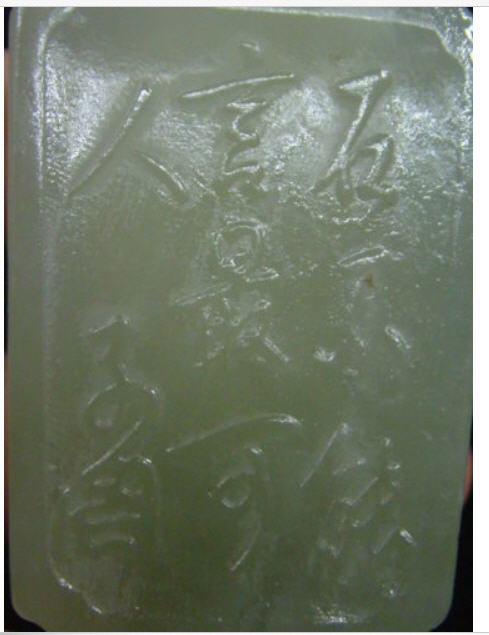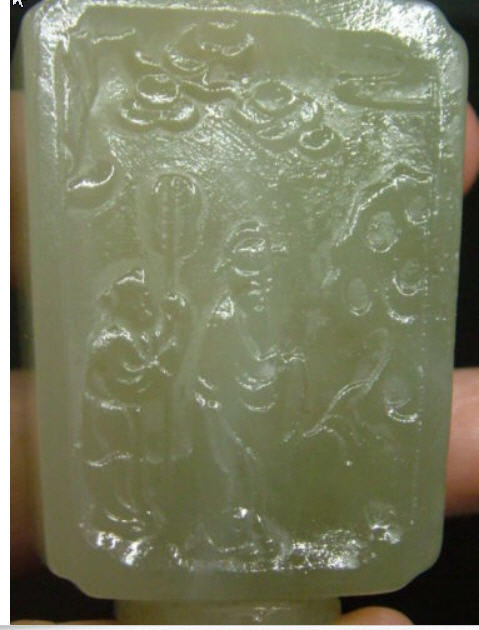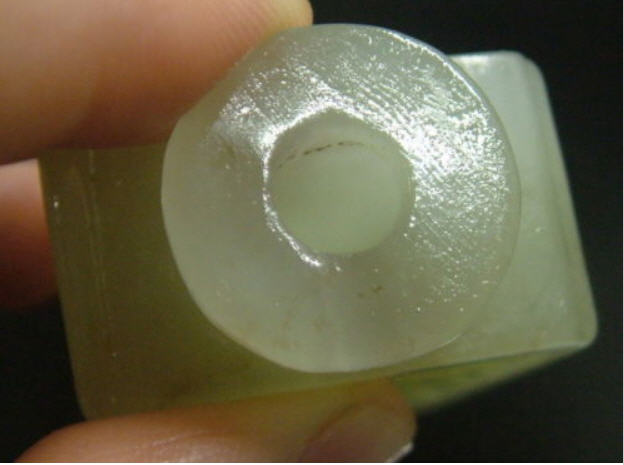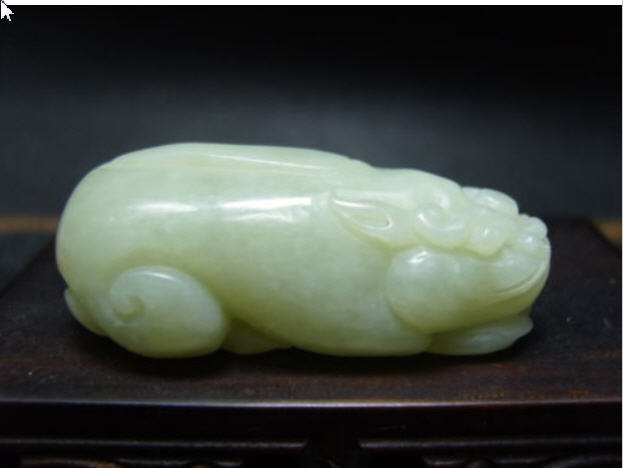
|
Subject:Re: Jade items offered by a UK seller? Are they real jades?
Posted By: Super Wed, Apr 11, 2018
Hi, David:
You are very welcome. It is not my intention to lecture anybody since I readily admit I do not know enough about jade to lecture others. But the more I learned about jade sometime the more discouraging I became because it is really not easy to acquire any nice and antique jade carvings. Forget about archaic jades, because I believe most of them are fakes or good imitations, even those that were sold by large auction houses. Forget about Neolithic jades, I had only seen one authentic one when a jade collector once tried to liquidate his whole Annam (Vietnamese) Neolithic jade collection on eBay and show some of them here. Many of them were broken pieces (like broken bracelets) but I immediately knew it was the real McCoy because the jade material used to make those jade bracelet was high quality Bi Yu (dark green nephrite jade) with staining that could only came from archaic jade. Anita Mui who once posted in this forum and later had her own forum was lucky enough to obtain a piece or two from this collector (Chad?). I did not know he would sell off single piece because his listing was for a whole collection. Now I truly regret I did not try to acquire a piece. I believe Anita might have posted pictures of some of the pieces from that collection in this forum but I could not find them. I did find this thread:
http://www.asianart.com/phpforum/index.php?method=detailAll&Id=35292
in which she mentioned about Chad's collection.
One of the pictures she posted (posted here also), shows the dark green jade material and staining of the jade bird on the left and large jade bracelet (ring) at the right that resemble those pieces in the jade collection. Without the privilege of obtaining and examining those pieces in the collection, I cannot say for sure they are 100% authentic but if any of these pieces show up in small auctions today, I believe they would fetch high prices. Sadly, large auction houses would probably turn down large collections like this due to a lack of provenance.
Another interesting myth is that average people/jade collectors may believe the older or more archaic the jades are, the more corroded (degraded) they would become. IMHO, that is absolutely not true because:
(1) Since in Neolithic and ancient China, it took a lot of time to "carve" and polish a jade carving. As a matter of fact, in early Qing dynasty, before polishing with "high" polishing material (e.g. quartz, diamond) was invented, it took one year or longer to polish a jade piece. Even today, with modern technology, for a master jade carver to finish a master piece (both carving and polishing, etc.), it will take one year or longer. Therefore you seldom see "inferior" material was being used to made any jade carvings in Qing dynasty or earlier. Most of the jade material used in making jade carvings in ancient China were hetian jades that were exported from Xinjiang (Hotan), sales of which, like sales of salt was being controlled by the government. In most dynasties, Xianjiang is not part of the Chinese border, until Qing Emperor QianLong had stopped the rebels in Xianjian, only then larger quantity of Hetian jades were being able to be transported from Xianjaing to the capital of China. A pair of white Hetian jade bowls, just material alone cost 5,000 taels of silver at that time, that is why today many authentic Qianlong jade carvings will cost a fortune. Another interesting fact is that it is not until middle Qing dynasty (I forget the exact year), jadeite was being considered as "jade" and used in the making of jade carvings. This is why if you ever see any Tang dynasty and Song dynasty jadeite carving for sales, you should take them with a grain of salt. In Song dynasty, the emperors were so weak and transport of quality hetian jade were greatly limited (many foreign invasions). Therefore, there were not as many nice heitan jade carvings from Song dynasty comparing with that from Qing dynasty.
Now for burial, a lot of time, because of the lesser status of some of the deceased or urgency of burial, lower quality of local jades (serpentine, etc.) were used.
In short, jade material, such as those used on authentic Hongshan jade, were often quality nephrite jade similar to Hetian jade, could not be scratched and nephrite jade was harder to be corroded even after long burial, many real Hongshan jades only needed to be cleaned and washed with soap and water, they would appear to be pristine;
(2) Quality polishing enable jade to stand long burial - many Neolithic or archaic jade pieces were polishing by hand, with animal belt and fat, for a long period of time. Therefore, it created a protective area and because of their quality material (nephrite, etc.), even if they were buried, it was very hard for them to be corroded unless they were damaged (if you do not believe me, try to obtain a nice piece of quality Heitan jade carving or dark green nephrite jade carving with great polishing (you can put some Vaseline on their surfaces), then put them in acid. I do not believe most acid will damage them.
(3) Burial - another myth is that all burial jades must be corroded by weather or soil element. For Hongshan burial, the jade carvings were stored in almost air tight stone coffins and then buried in higher ground, therefore the chance of the jade carving getting wet and had direct contact with soil was rare. In many large tombs in China, again, burial jades might not have direct contacts with air or burial elements. Even some of those wooden coffins in past century sometime lasted a long time, acting a protective barrier for burial jades.
I believe it would be lucky just for us to acquire some nice and authentic Qing dynasty jade carvings instead of trying to acquire any archaic or Neolithic jades.
In this Auction Results
Qing dynasty jades from a Hong Kong Collection
01 June 2017 | 10:00 AM HKT | Hong Kong
http://www.sothebys.com/en/auctions/2017/qing-dynasty-jade-carvings-from-hong-kong-collection-hk0771.html
There were tons of very nice Qing dynasty jade carvings with their realized prices which sold for a total of 9.94 Hong Kong dollars, about 1.27M US dollars at the exchange rate of 1 USD to 7.85 HK dollars. It appeared that many of these pieces were sold above their estimates and were not cheap. The cheapest price I saw was around USD$4000.
This is the link for realized prices in USD:
http://www.sothebys.com/en/auctions/2017/qing-dynasty-jade-carvings-from-hong-kong-collection-hk0771.html
Therefor I believe buying any white or celadon nephrite jade carving, especially those that were labeled as antique, Qing dynasty or Hetian jade can only be taken with a grain of salt.
Cheer.
Super
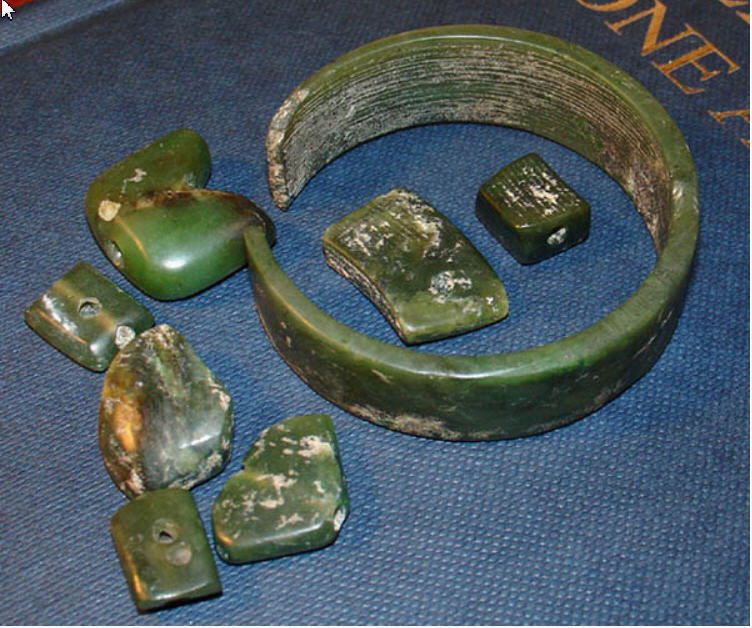


|
 Buying jade carvings on eBay or on line can be TREACHEROUS! ( China & Japan ) - Super - Apr 08, 2018 (02:44 PM)
Buying jade carvings on eBay or on line can be TREACHEROUS! ( China & Japan ) - Super - Apr 08, 2018 (02:44 PM)  Re: Buying jade carvings on eBay or on line can be TREACHEROUS!
Re: Buying jade carvings on eBay or on line can be TREACHEROUS!  - Super - Apr 09, 2018 (12:05 PM)
- Super - Apr 09, 2018 (12:05 PM)  Jade items offered by a UK seller? Are they real jades?
Jade items offered by a UK seller? Are they real jades?  - Super - Apr 09, 2018 (12:30 PM)
- Super - Apr 09, 2018 (12:30 PM)  Re: Jade items offered by a UK seller? Are they real jades? - David - Apr 10, 2018 (12:51 PM)
Re: Jade items offered by a UK seller? Are they real jades? - David - Apr 10, 2018 (12:51 PM)  Re: Jade items offered by a UK seller? Are they real jades?
Re: Jade items offered by a UK seller? Are they real jades?  - Super - Apr 11, 2018 (01:14 PM)
- Super - Apr 11, 2018 (01:14 PM)  Re: Buying jade carvings on eBay or on line can be TREACHEROUS!
Re: Buying jade carvings on eBay or on line can be TREACHEROUS!  - Eduardo - Aug 16, 2018 (10:55 AM)
- Eduardo - Aug 16, 2018 (10:55 AM)  Re: Buying jade carvings on eBay or on line can be TREACHEROUS! - Super - Aug 31, 2018 (10:26 AM)
Re: Buying jade carvings on eBay or on line can be TREACHEROUS! - Super - Aug 31, 2018 (10:26 AM)  Re: Buying jade carvings on eBay or on line can be TREACHEROUS! - Eduardo - Sep 01, 2018 (05:15 PM)
Re: Buying jade carvings on eBay or on line can be TREACHEROUS! - Eduardo - Sep 01, 2018 (05:15 PM)  Re: Buying jade carvings on eBay or on line can be TREACHEROUS! - rat - Aug 17, 2018 (10:35 AM)
Re: Buying jade carvings on eBay or on line can be TREACHEROUS! - rat - Aug 17, 2018 (10:35 AM)  Re: Buying jade carvings on eBay or on line can be TREACHEROUS! - Super - Aug 31, 2018 (10:35 AM)
Re: Buying jade carvings on eBay or on line can be TREACHEROUS! - Super - Aug 31, 2018 (10:35 AM) 